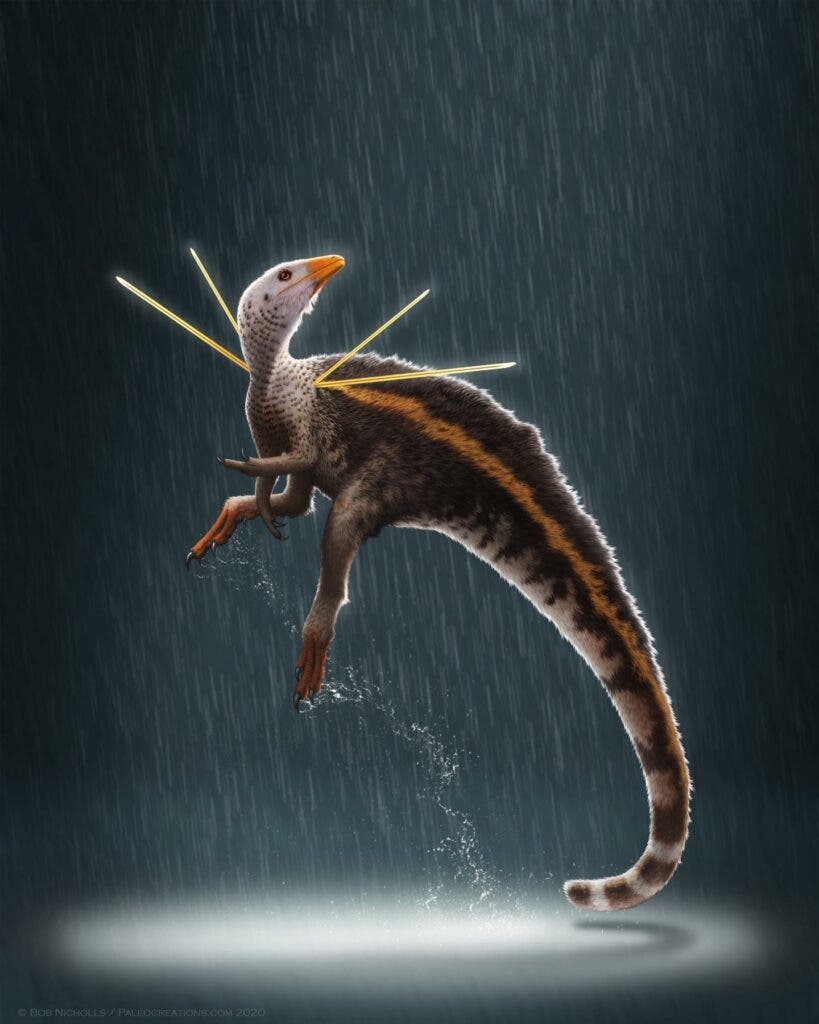
Ubirajara jubatus was not your typical dinosaur. The newly described, chicken-sized creature had a mane of long fur down its back and a pair of stiff ribbons projecting back from each shoulder. These flamboyant features served to impress potential mates or intimidate adversaries, more than 110 million years before the first peacocks evolved.
The new species was discovered while researchers examined fossils in the collection of the State Museum of Natural History in Karlsruhe, Germany.
Immediately, the international team of researchers, including David Martill, a professor of palaeobiology at the University of Portsmouth, were stunned by the stiff ribbons projecting from the small dinosaur’s shoulders.
These ribbons weren’t bones, nor scales or fur. Instead, the long, flat ribbons were made of keratin, the same material that hair and feathers are made of. Strikingly, the researchers could tell all of this judging from x-ray scans of previously hidden skeletal elements encased in two slabs of stone from Brazil’s Crato Formation, a shallow inland sea laid down about 110 million years ago.
“Interpreting crushed bones is always challenging and it is very easy to get things wrong,” Martill told ZME Science.
But why go to all this trouble if these ribbons didn’t serve to immediately put food on the table, especially if it made you a walking target to predators? While it’s true that survivability drives the evolution of species through natural selection, evolution also favors reproduction, so individuals who were selected for their sexual fitness were naturally favored and could pass on their genes.
The peacock is famous in this regard and is often used as a prime example of sexual selection. With his long, colorful feathers trailing behind him, the male peacock signals to the world: ‘Behold! I spare no resources to adorn myself even if that means making many foes.’ For some reason, females find that very appealing.
We may imagine that Ubirajara jubatus used in many regards its long shoulder ribbons as a peacock’s tail.
“I suppose that if the adornments were on the tail it could be called a peacock, but these are on the shoulders, so maybe it should be the ‘Captain’,” Martill said jokingly.
Although it’s impossible to determine the sex of an individual with 100% accuracy, its size suggests that it was a young male. Perhaps the small dinosaur was still learning how to use its dazzling ribbons to woo potential mates when it died.
These ribbons were positioned in such a way as not to impede freedom of movement in the arms and legs. Its long, thick mane is believed to have been controlled by muscles, so it could have raised similar to the way a dog raises its hackles or a porcupine raises its spines when threatened. But when it didn’t require any display, the mane could be lowered close to the skin, allowing the dinosaur to move swiftly through dense vegetation.
Bizarre as it might have been, Ubirajara jubatus is an important contribution to the fossil record of feathered non-avian dinosaurs, which are very scarce in Latin America.
“Everybody loves dinosaurs and usually are thrilled when we can say something new or fascinating about them. And this little dinosaur has lots of new things about it. What’s next? Well, I have to wait to see what comes out of the ground on my next field trip,” Martill said.
The findings appeared in the journal Cretaceous Research.






